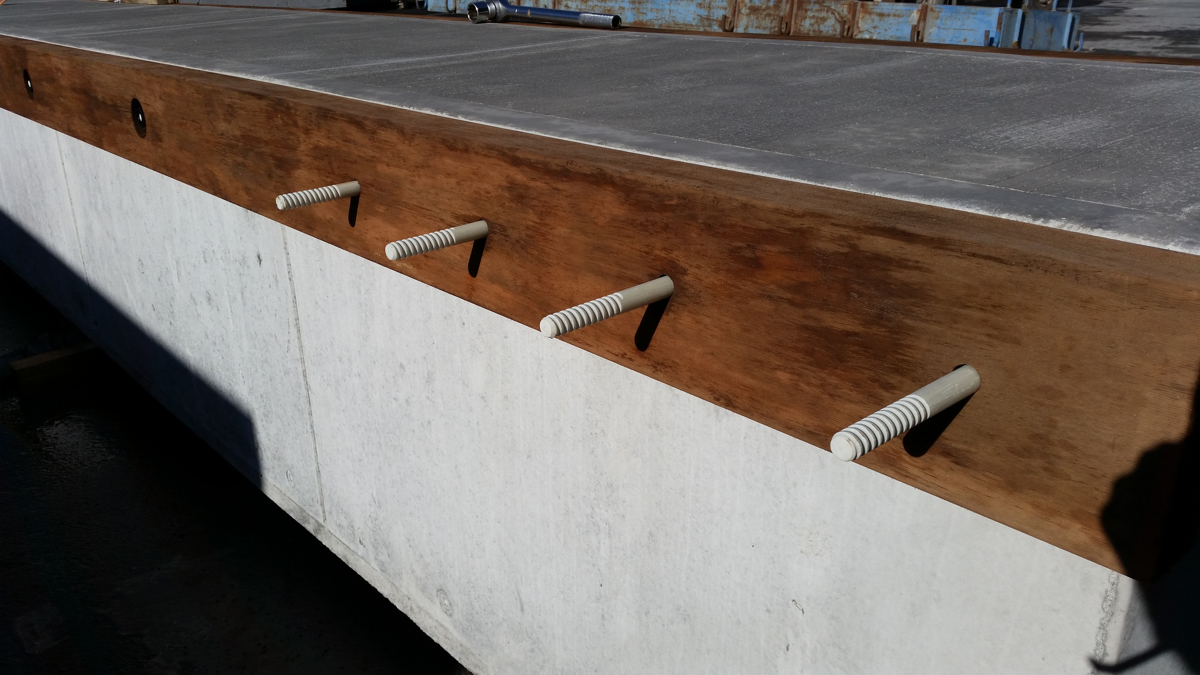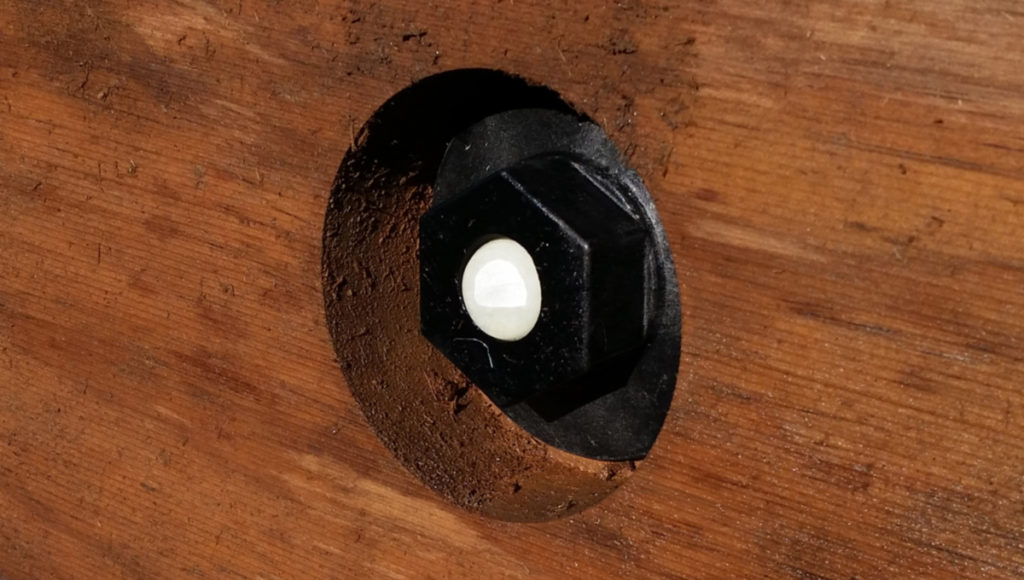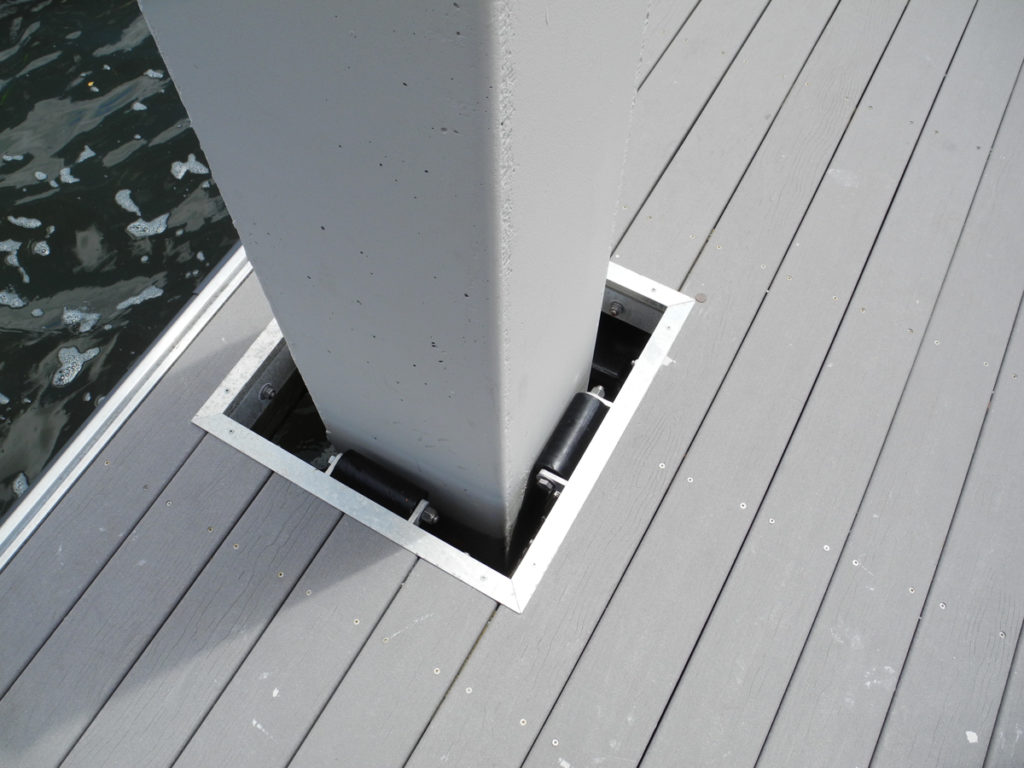
Walers and Thru-Rods Make Use of New Materials in Dock Construction
Published on December 1, 20172017 has been an exciting year for new materials in dock construction. Two new Fiberglass Reinforced Polymer (FRP) applications have emerged from years of R&D development and are on the market. In the fast-growing market of wood and aluminum docks, a handsome and rugged hybrid dock that combines the best of both materials was introduced.
The durable, stable, reliable concrete floating dock is the world standard heavy-duty dock and that is not changing. Two design challenges remain: corrosion in metal parts and the eternal quest for the zero maintenance dock.
Stainless steel thru-rods, washers and nuts make up a significant portion of the metal in a concrete dock system. Thru-rods attach the walers to the side of the dock and, because the walers are layered and lapped, they make the connection between modules. The timbers flex with the movement of the dock and physical “hinges” are not needed.
During the first six months following installation, it is common for the wood waler to shrink. This can cause the tension between the nuts at the end of the thru-rods and the waler to become loose. It’s a simple task to restore the tension and can be done with a set of hand tools. Manufacturers recommend annual inspection of the steel rods to ensure the nuts are tight.
Most marinas are regularly maintained but we are human; some of us are more human than others. If maintenance is delayed for years, the structure could be functioning well but below its design strength. FRP thru-rods are a response to this problem and to the ultimate materials-technology challenge: eliminate corrosion.
FRP Thru-rod Development
The FRP thru-rod has been in development by Pultron Composites, LTD, of New Zealand and Bellingham Marine for more than seven years. Parts are formed in a process called pultrusion that involves pulling glass fiber impregnated with resin through a die. The opposite, extrusion, pushes metal through a die and is more common.
Pultron Composites is in Gisborne, New Zealand. “We’re right on the International dateline, so are the first people on earth to see the sunrise,” said Pete Renshaw, business development manager.
Thru-rods presented a unique challenge. “We engineer for tensile and sheer strength,” Renshaw said, “but a thru-rod must have torsional strength as the glass-filled nylon nuts are tightened. We developed a proprietary resin formula and switched to a boron-free, highly corrosion-resistant fiber from Owens Corning called E-CR glass reinforcement for this application.”
There were other challenges. “When Pultron Composites sent samples for testing, we found two areas that we had to address,” said Everett Babbitt, president of Bellingham Marine. Babbitt has been quietly behind the development of FRP parts for docks for nearly 20 years. “First, the threads at the end of FRP rods required an innovative, custom-designed thread shape and thread pattern. After that, we found that determining torque specifications required lengthy field testing.
FRP has more stretch than steel, so the thru-rods stay tight. When the timber waler shrinks, the nut is still under tension, resulting in reduced maintenance for the operator. Pultron Composites and Bellingham Marine share ownership in the patent. More than 40,000 FRP thru-rods have been installed since the first non-test installation was completed in 2014 at Westhaven Marina in Auckland.
The FRP thru-rod is now available as original equipment or as a replacement part for existing Unifloat concrete marinas. “It will take years before we know how long an owner can go without tightening the nuts,” Babbitt said, “but it will be significantly longer than with steel thru-rods. We anticipate it may be decades, or even the life of the marina.”
FRP Walers

“We’ve been engineering FRP walers for at least 15 years,” said Craig Funston, president of Redpoint Structures. Redpoint is a Bellingham, Washington, structural engineering firm. “I’m very pleased with the results we’ve achieved. We set out to match the strength and fatigue resistance of wood. We did that, and we worked with our supplier to make the cost comparable.”
Creative Pultrusions of Pleasantville, PA, produces the walers. “They make sense for the marine environment,” said Dustin Troutman, director of marketing and product development. “They don’t rot, corrode or leach chemicals into the water.” In addition to walers, Creative Pultrusions manufactures FRP pile and sheet pile.
The key to the design was the cross section. Each cross section requires a new die, a significant investment in capital, production line configuration and engineering. As of now there are currently two cross sections available – rectangular and U-shaped. “As we see demand,” said Troutman, “we will be developing cross sections to meet any specification.”
The product is doing well, and the world is ready; environmental sensitivity is only increasing. “Wood is food to many microorganisms,” Funston said, “so if we want it to survive it requires some kind of biocide. The wood waler is out of the water. Reports from the American Wood Protection Association state leaching is null. But environmental regulations are getting tighter, especially in San Francisco Bay.”
Rue D’Amarres, an exclusive private marina north of Auckland, New Zealand, has both FRP thru-rods and FRP walers. “FRP components give us fewer things to worry about,” said Ian McKay, director/developer at Western Arm Marina, LTD. “In a saltwater environment, it’s comforting to know they’ll never corrode and on-going maintenance requirements will be minimal. FRP walers are an easy solution to ease the fears of concerned environmentalists. From all we have seen so far they behave identically to wood in strength and fatigue resistance.”
Bellingham Marine’s Babbitt sees a bright future for the new product. “The new walers look great,” he said. “They provide a sophisticated, modern look. Gray is the standard color, but we can provide them any color the customer wants.”
Aluminum Hybrid Dock

Aluminum is bright and alluring; jazzy, sleek and modern. Parts can be extruded in precise, space-age forms with hard-edged regularity that allows sliding tracks for accessories, such as adjustable cleats and movable pile hoop brackets.
But aluminum has drawbacks. It is light compared to other building materials. It offers less mass and is therefore less stable. It has poor fatigue characteristic relative to other materials and loses strength near welds.
Timber is the perfect complement to aluminum. It has mass, strength and fatigue resistance. “We combined the best of both.” said Mark Johnson, Bellingham Marine Timber. “The timbers are hidden so all your guests see is the beautiful aluminum exterior. We add composite, grated or wood decking as a customer choice.”
Bellingham Marine’s new product is called Unideck Aluminum TR for “Timber Reinforced.” A section was on display at the recent Marine Recreation Association Educational Conference and Trade Show. The dock is sleek and handsome with no feeling that disparate materials are present. The timbers are out of sight. Johnson said that the performance is identical in strength and durability to a full timber dock. The docks are manufactured at the company’s Wilmington, North Carolina, facility.
The hybrid aluminum-timber docks are installed at the U.S. Sailing Center in Miami, Florida. John Kearns of John Kearns Construction was the installer. “It’s a superior product,” Kearns said. “It was easy to put in and the sailors love them. It’s a crowd pleaser.”
Pat Downey is executive director of U.S. Sailing Center. We caught up with him in the middle of clean up from Hurricane Irma. “The docks are great, we like them. We had an 8-foot storm surge, but the concrete piling held and the docks came through the storm. We had some damage to the aluminum gangway. But it’s repairable.”
Conclusion
Like most successful products reaching their 60th year in service, the improvements tend to be less revolutionary than evolutionary, and FRP thru-rods and walers are just that. Nevertheless, these are important breakthroughs that took years of development. Fiberglass reinforced polymers are not new; in fact, many readers have used them in their workshops and garages. But for cutting edge industrial applications, a high level of engineering and manufacturing expertise is required. We see that in the development of these two new applications.
The hybrid timber reinforced aluminum dock is a bright idea in many ways, and should garner wide acceptance in marinas where a lighter-weight dock is appropriate, usually where expected wave heights are less than 1 foot.
Robert Wilkes writes about the marina industry from Bellevue, Washington.
| Categories | |
| Tags |






